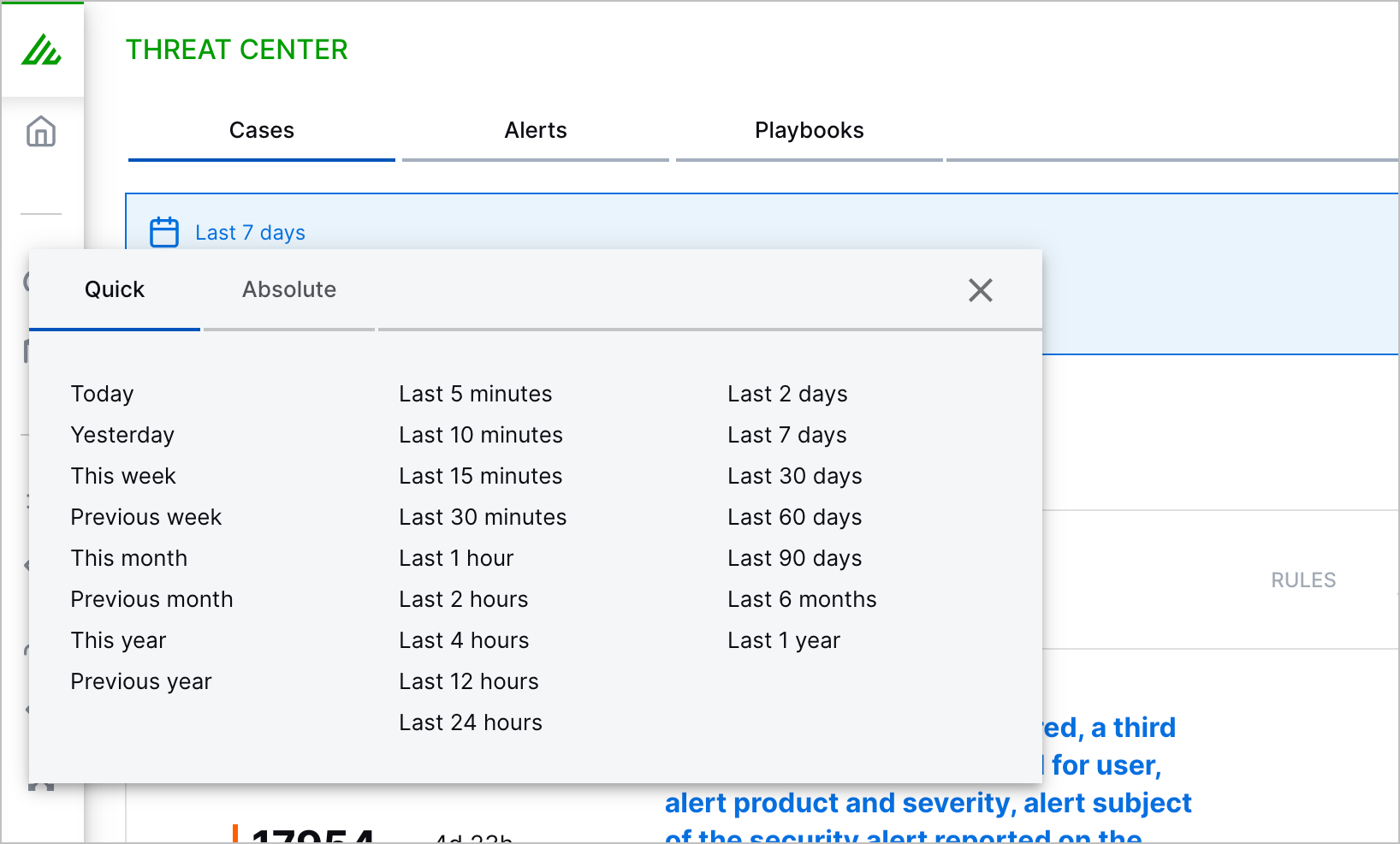- Get Started with Threat Center
- Group Detections
- Work on Cases
- Work on Alerts
- Edit and Collaborate in Threat Center
- Use Automation Tools in Threat Center
- Find Cases or Alerts
- Build a Search in Threat Center
- Enter a Search Using Exabeam Query Language in Threat Center
- Enter a Search Using Natural Language in Threat Center
- Run a Recent Search in Threat Center
- Create a New Saved Search in Threat Center
- Run a Saved Search in Threat Center
- Edit a Saved Search in Threat Center
- Delete a Saved Search in Threat Center
- Sort Cases or Alerts
- View Case and Alert Metrics
- Get Notified About Threat Center
Build a Search in Threat Center
Build a Search for Cases
To build a search for cases, navigate to the Cases tab, then click the search bar to specify your criteria. You only need to specify the criteria relevant to your search; there are no mandatory search criteria.
Navigate to the Cases tab, then in the Search mode menu, select Basic.
Click the search bar, then specify your search criteria:
Under VENDORS & PRODUCTS, select the vendors or products associated with the case and their related detections.
Under TOP USE CASES, select the use cases associated with the case and their related detections.
Under TOP TAGS, select the tags with which the related detections are tagged.
Under QUICK SEARCH, specify whether the cases are assigned to you or other users or contain any attachments:
To search for cases assigned to you, select Assigned to me. To search for cases not assigned to you, select Not assigned to me.
To search for cases assigned to your queue, select Assigned to my queue.
To search for cases that have any attachments, select With attachment.
Under CASE FIELDS, specify any attribute values the cases or their related detections contain or exclude:
Select a case or detection attribute.
Select whether the cases or their related detections contain or exclude the attribute value:
To search for alerts or related detections containing a specific attribute value, select IS.
To search for alerts or related detections without a specific attribute value, select IS NOT.
In the text box, enter a value.
Click Add to Query.
By default, the operator is AND. To change the operator, click the operator, then select another operator.
To specify when the cases were created, click the time range menu, then select a time range:

To select a time in the last few hours, days, months, or years, navigate to the Quick tab, then select a period.
To specify a range, navigate to the Absolute tab, enter specific dates and times, then click Apply.
Click Search
 .
.
Build a Search for Alerts
To build a search for alerts, navigate to the Alerts tab, then click the search bar to specify your search criteria. You only need to specify the criteria relevant to your search; there are no mandatory search criteria.
Navigate to the Alerts tab, then in the Search mode menu, select Basic.
Click the search bar, then specify your search criteria:
Under VENDORS & PRODUCTS, select the vendors or products associated with the alert and their related detections.
Under TOP USE CASES, select the use cases associated with the alert and their related detections.
Under TOP TAGS, select the tags with which related detections are tagged.
Under QUICK SEARCH, specify whether the alerts are associated with a case:
To search for alerts that have an associated case, select With case.
To search for alerts that don't have an associated case, select Without case.
Under ALERT FIELDS, specify any attribute values the alerts or their related detections contain or exclude:
Select an alert or detection attribute.
Select whether the alerts or their related detections contain or exclude the attribute value:
To search for alerts or related detections containing a specific attribute value, select IS.
To search for alerts or related detections without a specific attribute value, select IS NOT.
In the text box, enter a value.
Click Add to Query.
By default, the operator is AND. To change the operator, click the operator, then select another operator.
To specify when the alerts were created, click the time range menu, then select a time range:

To select a range in the last few hours, days, months, or years, click the Quick tab, then select a predefined range.
To specify a custom range, click the Absolute tab, enter specific dates and times, then click Apply.
Click Search
 .
.